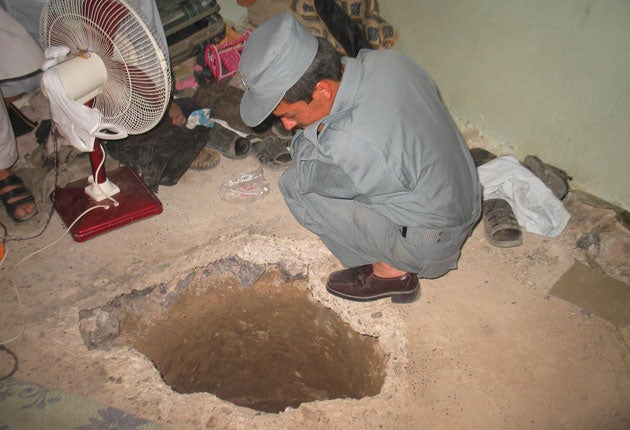The tunnel that allowed 488 Taliban prisoners to crawl 1,000ft to freedom
Remarkable escape from 'high-security' jail in Afghanistan

A huge manhunt was under way yesterday after 488 Taliban prisoners broke out of a high-security jail in southern Afghanistan, via a 1,000ft tunnel that snaked under checkpoints, razor-wire-tipped walls and a major highway before emerging in a house outside the perimeter.
Described by the Afghan government as a "disaster that should not have happened", the escape has made a mockery of the national security forces barely three months before Nato troops are due to hand over control of several parts of the country. Inside help is almost certainly to blame.
According to a triumphant Taliban spokesman, insurgents on the outside spent five months excavating the tunnel before finally breaking into one of the cells late on Sunday night, using car-jacks to crack through the final layer of concrete.
Over the next four-and-a-half hours, they whisked the 488 prisoners – including 13 common criminals – held in the political wing of Sarpoza jail to freedom, shuttling them away in waiting cars, while a team of suicide bombers stood ready to distract the prison guards.
As it turned out, there was little need. The warders only discovered that the inmates were gone at sunrise on Monday, half an hour after the last detainee had set off down the tunnel. To add insult to injury, sources in Kandahar said that the tunnellers used refurbishments to irrigation canals that were being funded by the US to conceal their digging.
"This is a blow," government spokesman Waheed Omar said. "A prison break of this magnitude of course points to a vulnerability." He said the government would investigate "what exactly happened" but analysts said there was every indication of an inside job, and this was backed up by a statement by one man who claimed yesterday to be one of the escapees.
"There were four or five of us who knew that our friends were digging a tunnel from the outside," explained Mohammad Abdullah, who said he had been an inmate for two years after being caught with a stockpile of guns. "Some of our friends helped us by providing copies of the keys. When the time came at night, we managed to open the doors for friends who were in other rooms."
Tooryalai Wesa, the governor of Kandahar, blamed the prison guards. "This is absolutely the fault of the ignorance of the security forces," he said. "This was not the work of a day, a week or a month of activities, this was actually months of work they spent to dig and free their men." Another official added that bombs left in the tunnel by the Taliban were hampering the investigation into what had happened.
It is not the first time inmates have escaped en masse from Sarpoza: almost 1,000 broke out during a Taliban attack in 2008. Following that incident, coalition forces in Kandahar spent millions of pounds upgrading the prison, building new guard towers, expanding the perimeter and strengthening cell doors and windows. Then, as now, inside help was suspected.
The jailbreak is the biggest in a series of propaganda coups this year for the Taliban, designed to undermine the credibility of Afghanistan's security forces and sap their morale ahead of the handover. But the escape could also have serious implications for the fighting season that is expected to start in the next few weeks.
Many are already predicting the bloodiest spring in a decade, as Nato troops try to cling to the gains they claim to have made in Kandahar since thousands of reinforcements poured in as part of US President Barack Obama's surge.
That forecast seems all the more likely now the Taliban's ranks have swollen so dramatically. Following the 2008 jailbreak, when fewer insurgents escaped than yesterday, the Afghan government was forced to deploy an extra 1,000 soldiers to Kandahar as hundreds of rebel fighters swarmed into villages, and seemed to threaten Kandahar City itself.
Kandahar holds particular importance for the Taliban, which seized the city in 1994 as it began its campaign to take over Afghanistan towards the end of the nation's brutal civil war. The Taliban held on to its stronghold city long after US and Nato forces drove the insurgents from power in the country, and a recent wave of assassinations shows they still have strength there.
Police showed reporters the roughly hewn hole that was punched through the cement floor of the prison cell. It was about 3ft in diameter.
Propaganda victories for the Taliban this year
* 18 April An insurgent dressed in an army uniform killed two people and wounded seven after infiltrating the ministry of defence in Kabul.
* 16 April A man posing as a soldier killed five Nato troops, four Afghan soldiers and an interpreter in a suicide bombing.
* 15 April A suicide bomber disguised as a policeman killed Kandahar province's chief of police.
* 14 April Three policemen were killed in a suicide bombing at a training centre in south-eastern Afghanistan.
* 7 April Six police died when militants drove an ambulance packed with explosives into a Kandahar police post.
* 19 February A Taliban gunman killed 42 Afghans, including women and children, in an attack on a bank where police were collecting their salaries.
Join our commenting forum
Join thought-provoking conversations, follow other Independent readers and see their replies
Comments